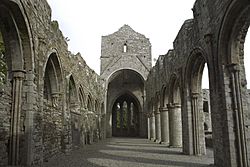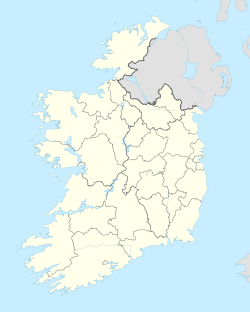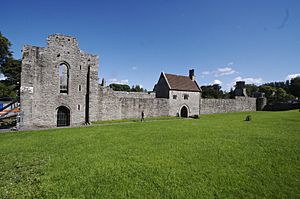Boyle Abbey facts for kids
| Mainistir na Búille | |

The interior of Boyle Abbey, looking east through the nave
|
|
| Monastery information | |
|---|---|
| Order | Cistercians |
| Established | 1218 |
| Disestablished | 1592 |
| Diocese | Elphin |
| People | |
| Founder(s) | Mac Diarmada family |
| Architecture | |
| Status | Inactive |
| Style | Cistercian |
| Site | |
| Location | Boyle, County Roscommon, Ireland |
| Coordinates | 53°58′25″N 8°17′49″W / 53.97361°N 8.29694°W |
| Public access | Yes |
| Official name | Boyle Abbey |
Boyle Abbey (which in Irish is Mainistir na Búille) is a beautiful old ruined abbey in Boyle, County Roscommon, Ireland. It was once home to a group of monks called Cistercians. The abbey was started by Saint Malachy in 1161. However, it wasn't fully finished and officially opened until 1218. Building work was stopped for a while because of a big event called the Anglo-Norman invasion of Ireland, and the abbey was even burned in 1202.
Contents
The Story of Boyle Abbey
In the 1100s, a very important person named Saint Malachy learned about two new groups of monks in France: the Cistercians and the Augustinians. He wanted to bring these groups to Ireland to help improve the old Irish church.
The first Cistercian abbey in Ireland was built at Mellifont, in County Louth, in 1142. Saint Malachy made sure that young Irish men who wanted to become Cistercian monks could train in France. They went to places like Saint Bernard's own monastery, Clairvaux Abbey.
Finding a Home for the Monks
The Cistercian monks were invited to set up an abbey in an area called Moylurg. In 1148, a monk named Peter O’Mordha and twelve friends were sent to Connacht to find a good spot. They tried a few places before finally settling at Boyle.
Cistercian monks were vegetarians, so they needed a lot of farmland near their monastery. They also needed easy access to running water for cooking, washing, and toilets. They were offered an old Celtic monastery called Eas Mic nEirc (or Assylin). This place was near a major river crossing where many roads met. The old monastery had very few monks, or perhaps none at all.
A local leader, Taoiseach McGreevy, gave this old monastery to the Cistercians as a gift. This meant they could use it forever without any conditions.
Building the Abbey
The Cistercians were welcomed, and over many years, they received large areas of land. These lands, about 50,000 acres, were spread out in 27 smaller farms called granges. However, the monks found the Assylin site wasn't quite right for their needs. It was too high above the river.
So, they decided to build the abbey a few kilometers to the east, at the spot where it stands today. This new location was much better because it had running water right on the site. This was perfect for their daily needs, like cooking and washing. It was also good for building important things like mills and fish ponds.
Boyle Abbey was officially founded in 1161.
Challenges and Changes
The monastery did very well at first. It even helped start two other abbeys: Knockmoy Abbey in County Galway and Assaroe Abbey in County Donegal. By 1174, Boyle Abbey was important enough to be called an "Abbey."
However, building the abbey took a long time. It wasn't fully finished until about 1218, when it was officially opened. This was partly because of a war in 1202. During this war, the abbey was taken over and badly damaged. You can still see signs of this damage in the different building styles in parts of the church.
The abbey's history continued to be eventful. In the 1220s, Boyle Abbey was involved in something called ‘The Conspiracy of Mellifont.’ This was when Mellifont Abbey and its daughter houses tried to break away from Norman control. After this was sorted out, the abbey was attacked several more times, like in 1235 and 1284.
Later, new groups of monks, like the Franciscans and Dominicans, came to Ireland. These new groups offered a different way of life that suited the local culture more. Because of this, fewer lay brothers (who worked the farms) joined the Cistercians. This meant many of the abbey's farms had to be rented out.
Even so, the abbey continued its daily life. In the late 1200s and early 1300s, the abbots (leaders) of Boyle Abbey often became bishops of Elphin. But by the end of the 1400s, the local chieftain's family seemed to take control of the abbey, with one of their family members often becoming the abbot.
When Queen Elizabeth closed down many monasteries, Boyle Abbey's lands were given to a new owner. However, this new owner allowed the Cistercian monks to stay. The last abbot, Gelasius Ó Cuileanáin, was sadly executed in Dublin in 1580.
What Boyle Abbey Looked Like
Boyle Abbey was built following a common plan for Cistercian monasteries. The church was on the north side of a rectangular area called a cloister. The cloister was a peaceful courtyard where monks could walk and pray.
Around the cloister, there were other important buildings:
- A chapter house for meetings.
- A kitchen and a refectory (dining hall).
- Probably storehouses and dormitories (sleeping areas) above.
Only small parts of the cloister remain today. This is because it was used as a barracks (a place for soldiers) by the English in 1592. It was also attacked in 1645. These events, along with people possibly taking stones from the ruins later, meant that much of the cloister was lost.
Despite this, the ruins are still very impressive! A short, square tower stands tall above the center of the church. This tower was added around the 1200s. The church itself has a main area called a nave with side aisles. It also has transepts (arms of the church) to the north and south, each with two small chapels. The main altar area is called the chancel.
The design of the abbey was influenced by styles from Burgundy, a region in France where the Cistercians came from. However, many details, especially the round pillars in the south arcade of the nave, look a lot like buildings from the West of England. The decorated corbels (support stones) and capitals (tops of pillars) were likely carved by local stonemasons. Some of these carvers were part of a group known as the ‘School of the West.’ They created some of the most creative stone sculptures in western Ireland during the early 1200s.
Boyle Abbey Today
Today, Boyle Abbey is a national monument looked after by the state. You can visit it for a small fee. It's a great place to explore and imagine what life was like for the monks centuries ago. The abbey is located in Boyle, County Roscommon.
Australian Connection
A small piece of stone from Boyle Abbey traveled all the way to Sydney, Australia. It was placed on the headstone of an Irishman named Bartholomew Higgins in the Rookwood Necropolis cemetery.
See also
 In Spanish: Abadía de Boyle para niños
In Spanish: Abadía de Boyle para niños
- List of abbeys and priories in Ireland (County Roscommon)



